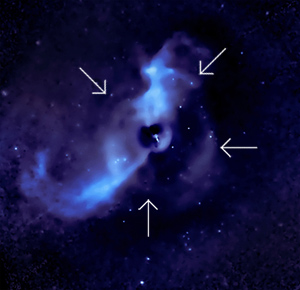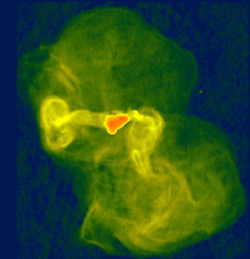Some 60 million light years from Earth is the monster galaxy M87. It’s a massive elliptical galaxy, one of the largest such in the nearby Universe… if you count 600 quintillion kilometers away as “nearby”.
And when it comes to the Universe, I do.
It sits in the center of the Virgo cluster, a collection of roughly 1500 galaxies all bound to each other by gravity. At the heart of M87 is one of the biggest black holes ever seen: something like 6 billion times the mass of the Sun (the Milky Way has one as well, but it’s a paltry 4 million solar masses). It’s called a supermassive black hole, and it’s active. That means it’s a sloppy eater: as matter falls in to the hole, it piles up outside and forms a giant disk, which gets hot… millions of degrees hot. The tremendous heat and other titanic forces join up to blast away a huge amount of the otherwise incoming material. It’s not a nice, neat process, and when a black hole on that scale lets out a belch, it’s felt for hundreds of trillions of kilometers… as you can see in this image:
[Click to supermassivize.]
This is a composite of two images, one taken in radio wavelengths by the Very Large Array (in red) and the other in X-rays by the orbiting Chandra Observatory (in blue). The X-rays are being emitted by gas blasting away from the black hole, heated up by the disk and the magnetic fields affiliated with the hole itself. The radio waves are from gas that previously existed outside and farther away from the black hole, which is being slammed into, stirred up, and swept away by the outflowing gas.
 The Chandra image alone shows that better. The thin oval of X-ray emitting gas marks the location off a vast shock wave, just like the sonic boom off a jet fighter. It looks like at some point in the past, the black hole erupted, exploding like a volcano and spewing out a vast sheet of material. As it expanded, it collided with the gas already there, compressing it, and creating the ring of shocked material.
The Chandra image alone shows that better. The thin oval of X-ray emitting gas marks the location off a vast shock wave, just like the sonic boom off a jet fighter. It looks like at some point in the past, the black hole erupted, exploding like a volcano and spewing out a vast sheet of material. As it expanded, it collided with the gas already there, compressing it, and creating the ring of shocked material.
Clusters of galaxies have lots of extremely hot gas floating around between the galaxies. It was once thought that this gas would cool by emitting X-rays, then fall to the center of the cluster, where it could form stars. These are called “cooling flows”, and a lot of work was done on them in the 1990s. But this image shows us the reality is more complicated. The infalling gas has to deal with outflowing gas from the black hole, and a balance of sorts is achieved. But it’s a dynamic balance: lots of motion, shock waves, eruptions, and the blasting out of energy on a colossal scale. In one single second, M87 gives off as much energy in X-rays as the Sun does across the electromagnetic spectrum in an entire year!
So yeah, colossal.
 The upshot is that all that infalling gas gets stirred up and can’t form stars. The constant wind – and sometimes eruptive explosions – from the black hole prevents it, and so millions, maybe even billions of stars never get the chance to be born.
The upshot is that all that infalling gas gets stirred up and can’t form stars. The constant wind – and sometimes eruptive explosions – from the black hole prevents it, and so millions, maybe even billions of stars never get the chance to be born.
I’ll note that this news isn’t exactly new. The VLA image is from 1999*, when it was seen that the infalling gas must have been balanced by the gas moving out. But the Chandra image shows the detail of it, how the two are colliding, and how violent and complex the interaction is. Even as our technology improves and we get clearer and more detailed images, old observations and new together tell us a lot more.
Image credits: X-ray (NASA/CXC/KIPAC/N. Werner, E. Million et al); Radio (NRAO/AUI/NSF/F. Owen)
*And, for obvious reasons, was included in my talk at w00tstock (which also has video).